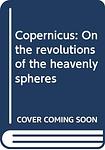Nicolaus Copernicus
Nicolaus Copernicus was a Renaissance-era polymath whose theory of the universe, placing the Sun rather than the Earth at the center, formed the foundation for modern astronomy. His seminal work, 'De revolutionibus orbium coelestium' (On the Revolutions of the Celestial Spheres), published in 1543, is considered a major event in the history of science, triggering the Copernican Revolution and contributing significantly to the Scientific Revolution.
Books
This list of books are ONLY the books that have been ranked on the lists that are aggregated on this site. This is not a comprehensive list of all books by this author.
-
1. On the Revolutions of the Heavenly Spheres
This book presents the revolutionary astronomical model that places the sun, rather than the earth, at the center of the universe. The author challenges the geocentric model of the cosmos, which had been widely accepted since the time of Aristotle, and instead proposes a heliocentric system, where the planets orbit the sun. This revolutionary idea transformed the way we understand our place in the universe, paving the way for modern astronomy and science.
-
2. Commentariolus
"Commentariolus" is a brief astronomical treatise that outlines the heliocentric theory, proposing that the Sun is stationary at the center of the universe and that the Earth, spinning on its axis once daily, revolves around the Sun annually. This revolutionary model challenged the long-held geocentric views of Ptolemy and Aristotle, suggesting instead a universe with planets, including Earth, orbiting in circular paths. The work, not widely circulated during its time, laid foundational ideas that would later be expanded and detailed, significantly altering the course of astronomy and science by challenging the way humans perceived the structure of their universe.

